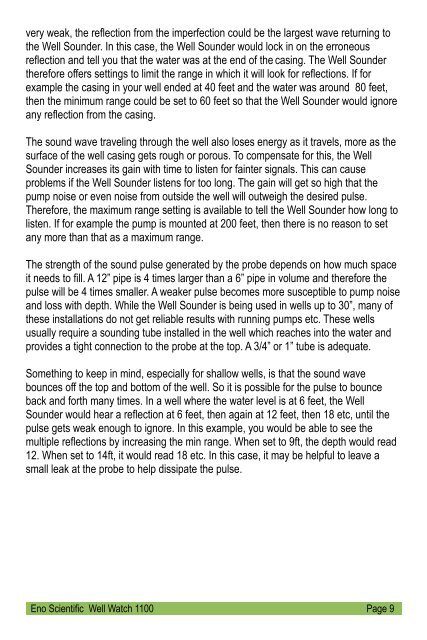WELL WATCH 1100 USER MANUAL - Eno Scientific
WELL WATCH 1100 USER MANUAL - Eno Scientific
WELL WATCH 1100 USER MANUAL - Eno Scientific
You also want an ePaper? Increase the reach of your titles
YUMPU automatically turns print PDFs into web optimized ePapers that Google loves.
very weak, the reflection from the imperfection could be the largest wave returning to<br />
the Well Sounder. In this case, the Well Sounder would lock in on the erroneous<br />
reflection and tell you that the water was at the end of the casing. The Well Sounder<br />
therefore offers settings to limit the range in which it will look for reflections. If for<br />
example the casing in your well ended at 40 feet and the water was around 80 feet,<br />
then the minimum range could be set to 60 feet so that the Well Sounder would ignore<br />
any reflection from the casing.<br />
The sound wave traveling through the well also loses energy as it travels, more as the<br />
surface of the well casing gets rough or porous. To compensate for this, the Well<br />
Sounder increases its gain with time to listen for fainter signals. This can cause<br />
problems if the Well Sounder listens for too long. The gain will get so high that the<br />
pump noise or even noise from outside the well will outweigh the desired pulse.<br />
Therefore, the maximum range setting is available to tell the Well Sounder how long to<br />
listen. If for example the pump is mounted at 200 feet, then there is no reason to set<br />
any more than that as a maximum range.<br />
The strength of the sound pulse generated by the probe depends on how much space<br />
it needs to fill. A 12” pipe is 4 times larger than a 6” pipe in volume and therefore the<br />
pulse will be 4 times smaller. A weaker pulse becomes more susceptible to pump noise<br />
and loss with depth. While the Well Sounder is being used in wells up to 30”, many of<br />
these installations do not get reliable results with running pumps etc. These wells<br />
usually require a sounding tube installed in the well which reaches into the water and<br />
provides a tight connection to the probe at the top. A 3/4” or 1” tube is adequate.<br />
Something to keep in mind, especially for shallow wells, is that the sound wave<br />
bounces off the top and bottom of the well. So it is possible for the pulse to bounce<br />
back and forth many times. In a well where the water level is at 6 feet, the Well<br />
Sounder would hear a reflection at 6 feet, then again at 12 feet, then 18 etc, until the<br />
pulse gets weak enough to ignore. In this example, you would be able to see the<br />
multiple reflections by increasing the min range. When set to 9ft, the depth would read<br />
12. When set to 14ft, it would read 18 etc. In this case, it may be helpful to leave a<br />
small leak at the probe to help dissipate the pulse.<br />
<strong>Eno</strong> <strong>Scientific</strong> Well Watch <strong>1100</strong> Page 9


